Contemporary Management Theory: Johnson and Scholes Cultural Web and Charles Handy Model
VerifiedAdded on 2023/06/14
|8
|2139
|244
AI Summary
This report discusses the impact of organizational culture on performance and how to evaluate it using Johnson and Scholes cultural web and Charles Handy model. It explains the six interconnected elements of the cultural web and the four types of culture in the Handy model. The report also highlights the role of management and leadership in creating a healthy organizational culture.
Contribute Materials
Your contribution can guide someone’s learning journey. Share your
documents today.
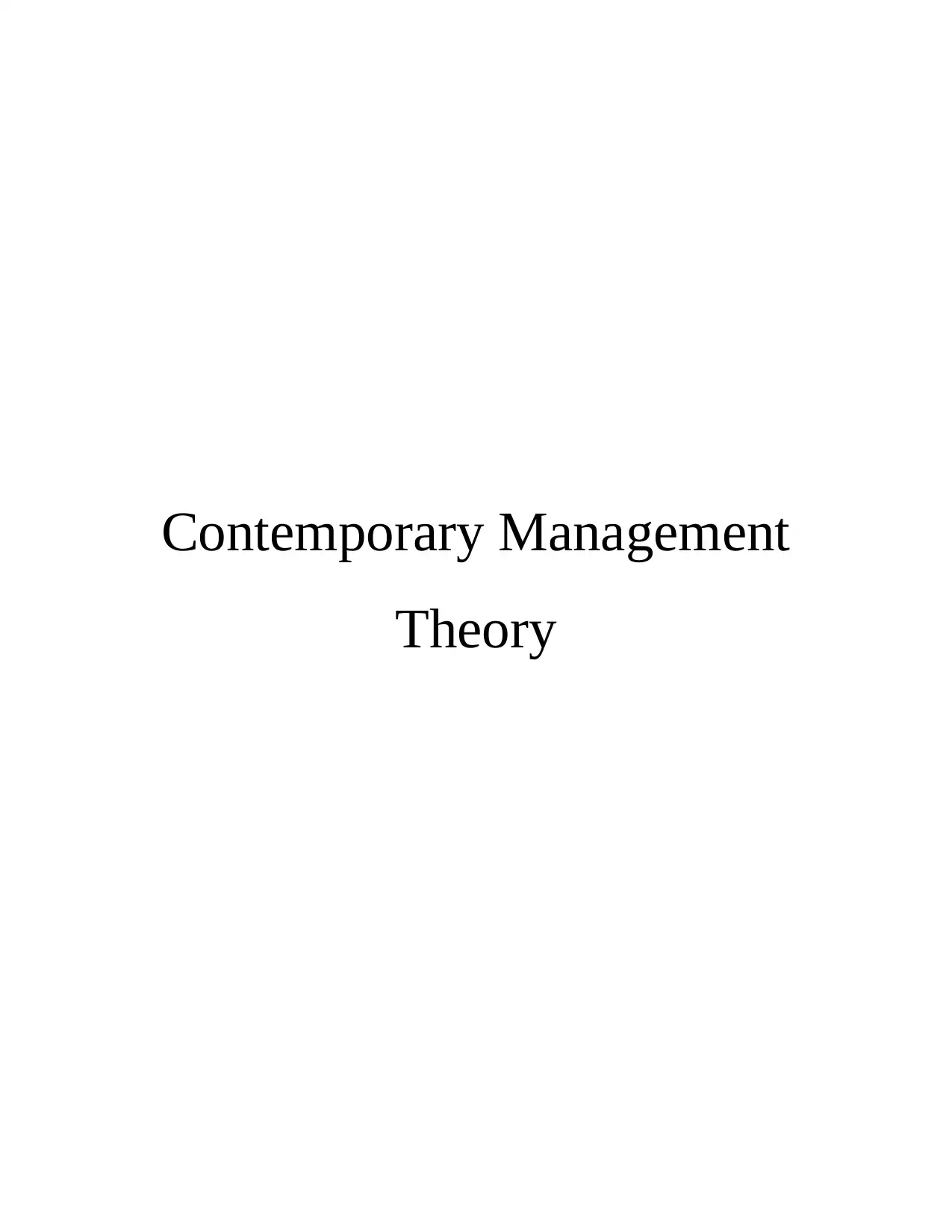
Contemporary Management
Theory
Theory
Secure Best Marks with AI Grader
Need help grading? Try our AI Grader for instant feedback on your assignments.
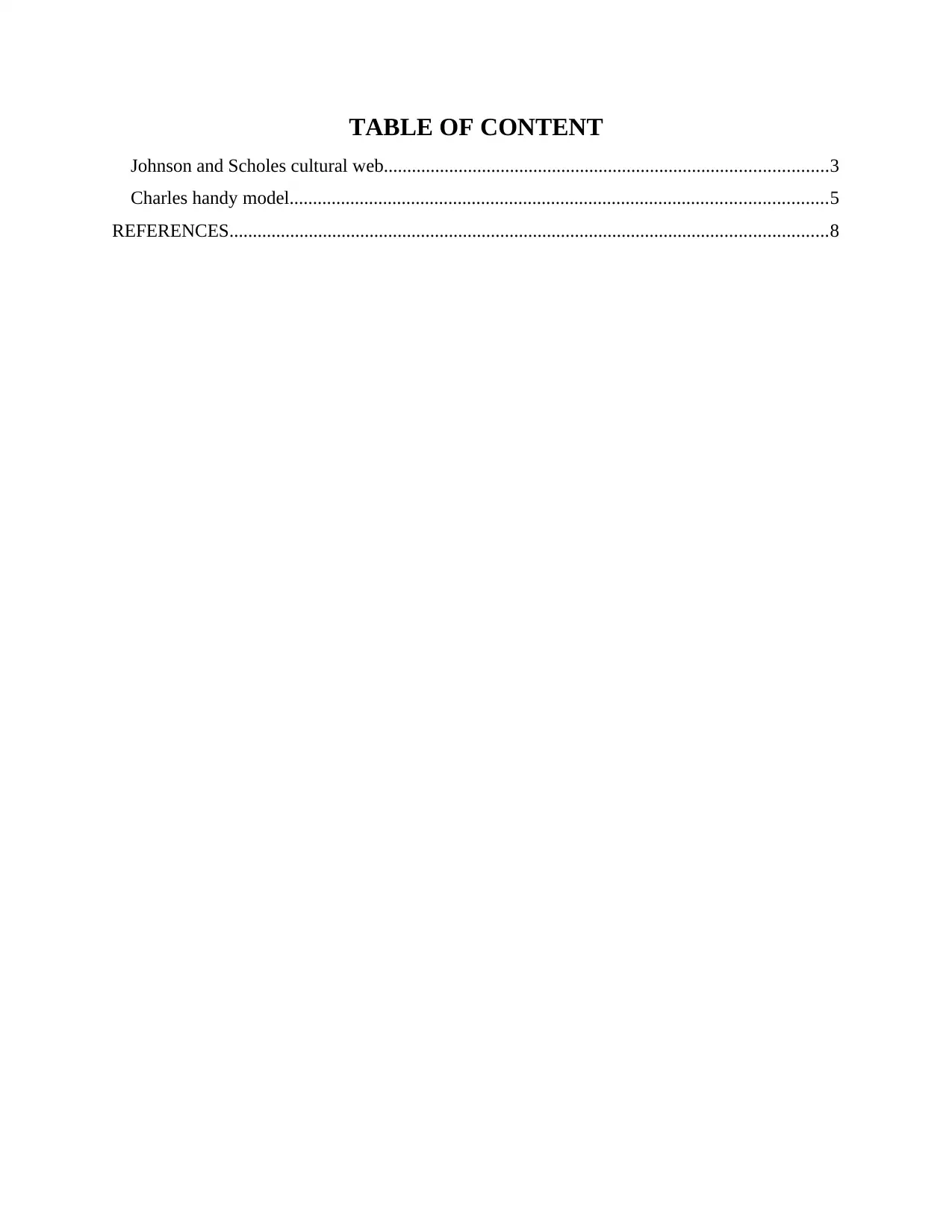
TABLE OF CONTENT
Johnson and Scholes cultural web...............................................................................................3
Charles handy model...................................................................................................................5
REFERENCES................................................................................................................................8
Johnson and Scholes cultural web...............................................................................................3
Charles handy model...................................................................................................................5
REFERENCES................................................................................................................................8
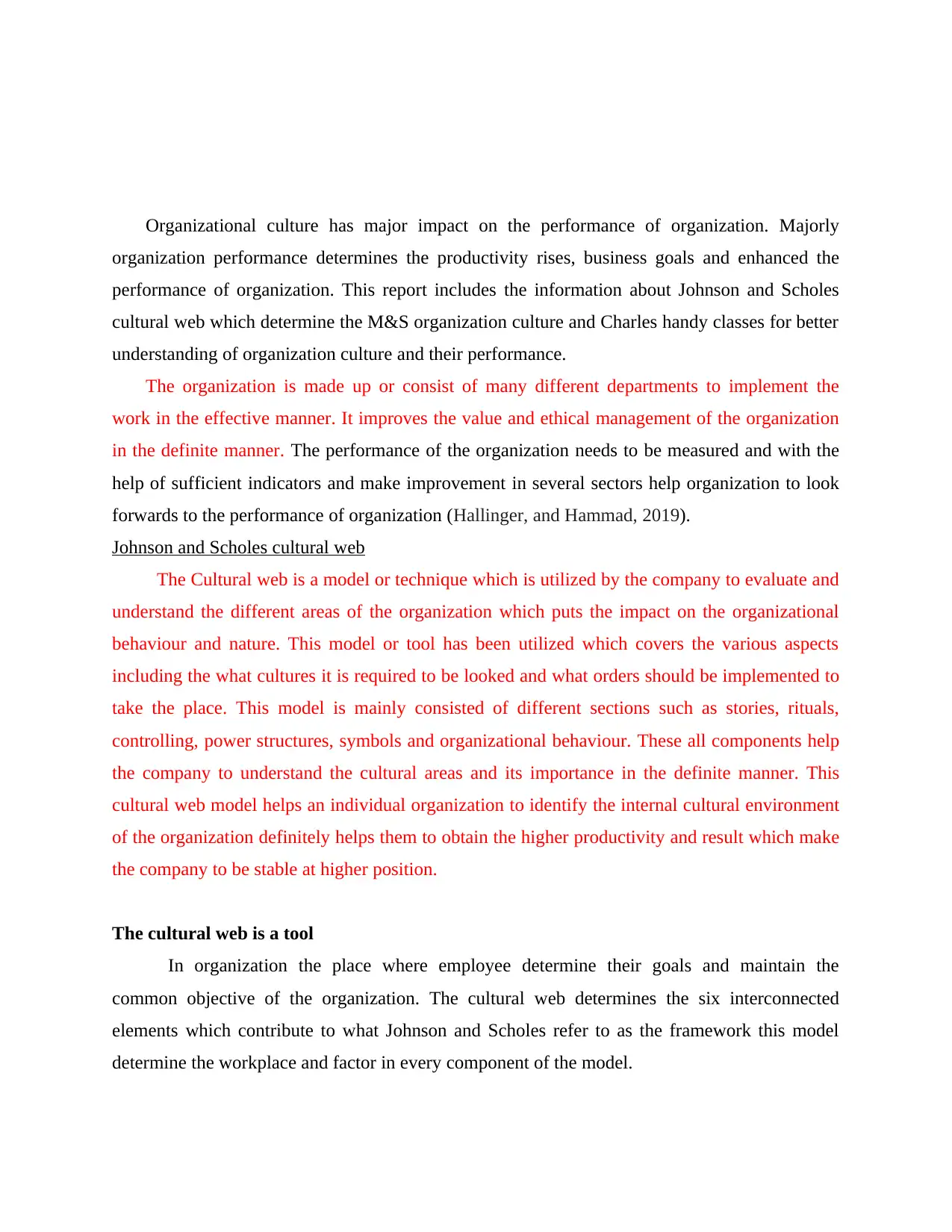
Organizational culture has major impact on the performance of organization. Majorly
organization performance determines the productivity rises, business goals and enhanced the
performance of organization. This report includes the information about Johnson and Scholes
cultural web which determine the M&S organization culture and Charles handy classes for better
understanding of organization culture and their performance.
The organization is made up or consist of many different departments to implement the
work in the effective manner. It improves the value and ethical management of the organization
in the definite manner. The performance of the organization needs to be measured and with the
help of sufficient indicators and make improvement in several sectors help organization to look
forwards to the performance of organization (Hallinger, and Hammad, 2019).
Johnson and Scholes cultural web
The Cultural web is a model or technique which is utilized by the company to evaluate and
understand the different areas of the organization which puts the impact on the organizational
behaviour and nature. This model or tool has been utilized which covers the various aspects
including the what cultures it is required to be looked and what orders should be implemented to
take the place. This model is mainly consisted of different sections such as stories, rituals,
controlling, power structures, symbols and organizational behaviour. These all components help
the company to understand the cultural areas and its importance in the definite manner. This
cultural web model helps an individual organization to identify the internal cultural environment
of the organization definitely helps them to obtain the higher productivity and result which make
the company to be stable at higher position.
The cultural web is a tool
In organization the place where employee determine their goals and maintain the
common objective of the organization. The cultural web determines the six interconnected
elements which contribute to what Johnson and Scholes refer to as the framework this model
determine the workplace and factor in every component of the model.
organization performance determines the productivity rises, business goals and enhanced the
performance of organization. This report includes the information about Johnson and Scholes
cultural web which determine the M&S organization culture and Charles handy classes for better
understanding of organization culture and their performance.
The organization is made up or consist of many different departments to implement the
work in the effective manner. It improves the value and ethical management of the organization
in the definite manner. The performance of the organization needs to be measured and with the
help of sufficient indicators and make improvement in several sectors help organization to look
forwards to the performance of organization (Hallinger, and Hammad, 2019).
Johnson and Scholes cultural web
The Cultural web is a model or technique which is utilized by the company to evaluate and
understand the different areas of the organization which puts the impact on the organizational
behaviour and nature. This model or tool has been utilized which covers the various aspects
including the what cultures it is required to be looked and what orders should be implemented to
take the place. This model is mainly consisted of different sections such as stories, rituals,
controlling, power structures, symbols and organizational behaviour. These all components help
the company to understand the cultural areas and its importance in the definite manner. This
cultural web model helps an individual organization to identify the internal cultural environment
of the organization definitely helps them to obtain the higher productivity and result which make
the company to be stable at higher position.
The cultural web is a tool
In organization the place where employee determine their goals and maintain the
common objective of the organization. The cultural web determines the six interconnected
elements which contribute to what Johnson and Scholes refer to as the framework this model
determine the workplace and factor in every component of the model.
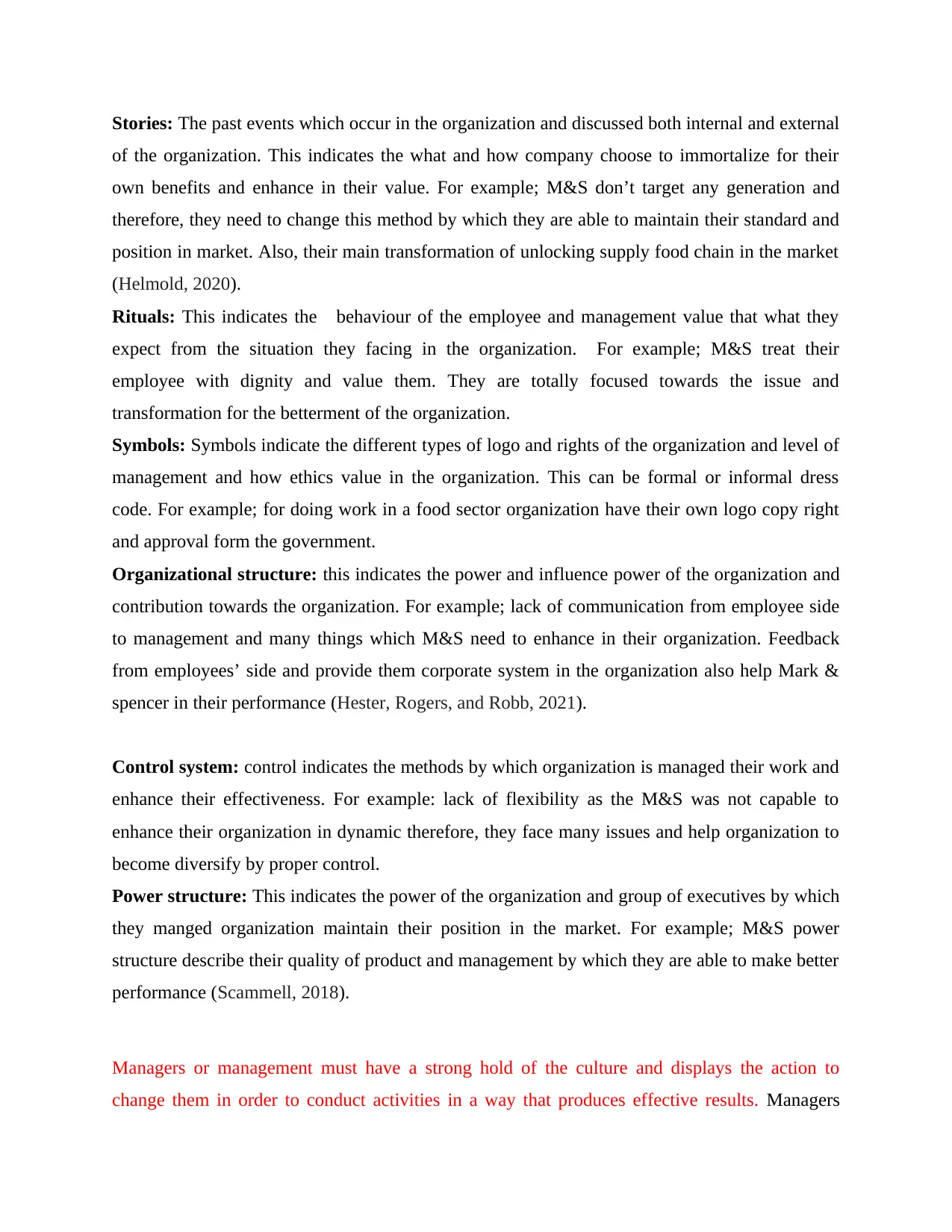
Stories: The past events which occur in the organization and discussed both internal and external
of the organization. This indicates the what and how company choose to immortalize for their
own benefits and enhance in their value. For example; M&S don’t target any generation and
therefore, they need to change this method by which they are able to maintain their standard and
position in market. Also, their main transformation of unlocking supply food chain in the market
(Helmold, 2020).
Rituals: This indicates the behaviour of the employee and management value that what they
expect from the situation they facing in the organization. For example; M&S treat their
employee with dignity and value them. They are totally focused towards the issue and
transformation for the betterment of the organization.
Symbols: Symbols indicate the different types of logo and rights of the organization and level of
management and how ethics value in the organization. This can be formal or informal dress
code. For example; for doing work in a food sector organization have their own logo copy right
and approval form the government.
Organizational structure: this indicates the power and influence power of the organization and
contribution towards the organization. For example; lack of communication from employee side
to management and many things which M&S need to enhance in their organization. Feedback
from employees’ side and provide them corporate system in the organization also help Mark &
spencer in their performance (Hester, Rogers, and Robb, 2021).
Control system: control indicates the methods by which organization is managed their work and
enhance their effectiveness. For example: lack of flexibility as the M&S was not capable to
enhance their organization in dynamic therefore, they face many issues and help organization to
become diversify by proper control.
Power structure: This indicates the power of the organization and group of executives by which
they manged organization maintain their position in the market. For example; M&S power
structure describe their quality of product and management by which they are able to make better
performance (Scammell, 2018).
Managers or management must have a strong hold of the culture and displays the action to
change them in order to conduct activities in a way that produces effective results. Managers
of the organization. This indicates the what and how company choose to immortalize for their
own benefits and enhance in their value. For example; M&S don’t target any generation and
therefore, they need to change this method by which they are able to maintain their standard and
position in market. Also, their main transformation of unlocking supply food chain in the market
(Helmold, 2020).
Rituals: This indicates the behaviour of the employee and management value that what they
expect from the situation they facing in the organization. For example; M&S treat their
employee with dignity and value them. They are totally focused towards the issue and
transformation for the betterment of the organization.
Symbols: Symbols indicate the different types of logo and rights of the organization and level of
management and how ethics value in the organization. This can be formal or informal dress
code. For example; for doing work in a food sector organization have their own logo copy right
and approval form the government.
Organizational structure: this indicates the power and influence power of the organization and
contribution towards the organization. For example; lack of communication from employee side
to management and many things which M&S need to enhance in their organization. Feedback
from employees’ side and provide them corporate system in the organization also help Mark &
spencer in their performance (Hester, Rogers, and Robb, 2021).
Control system: control indicates the methods by which organization is managed their work and
enhance their effectiveness. For example: lack of flexibility as the M&S was not capable to
enhance their organization in dynamic therefore, they face many issues and help organization to
become diversify by proper control.
Power structure: This indicates the power of the organization and group of executives by which
they manged organization maintain their position in the market. For example; M&S power
structure describe their quality of product and management by which they are able to make better
performance (Scammell, 2018).
Managers or management must have a strong hold of the culture and displays the action to
change them in order to conduct activities in a way that produces effective results. Managers
Secure Best Marks with AI Grader
Need help grading? Try our AI Grader for instant feedback on your assignments.
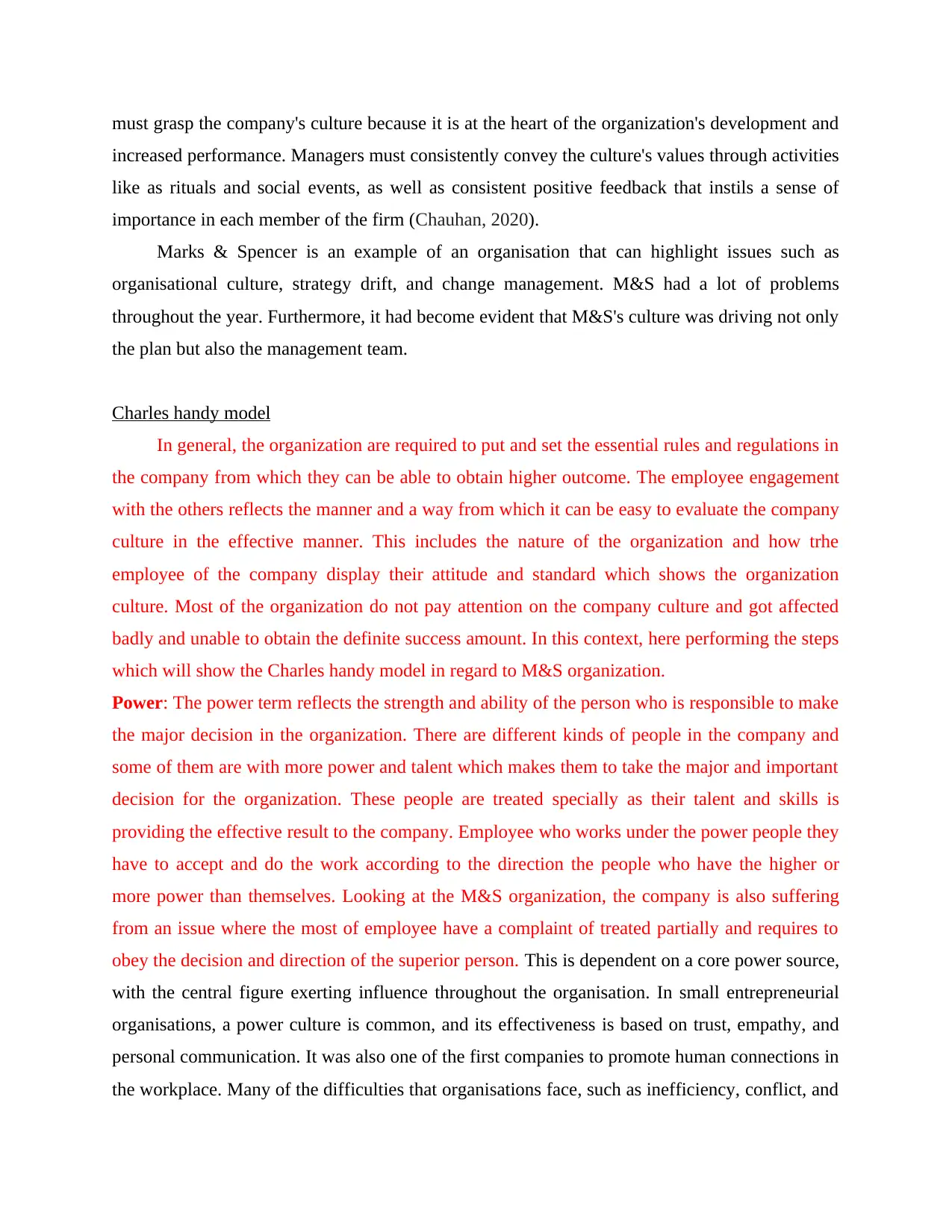
must grasp the company's culture because it is at the heart of the organization's development and
increased performance. Managers must consistently convey the culture's values through activities
like as rituals and social events, as well as consistent positive feedback that instils a sense of
importance in each member of the firm (Chauhan, 2020).
Marks & Spencer is an example of an organisation that can highlight issues such as
organisational culture, strategy drift, and change management. M&S had a lot of problems
throughout the year. Furthermore, it had become evident that M&S's culture was driving not only
the plan but also the management team.
Charles handy model
In general, the organization are required to put and set the essential rules and regulations in
the company from which they can be able to obtain higher outcome. The employee engagement
with the others reflects the manner and a way from which it can be easy to evaluate the company
culture in the effective manner. This includes the nature of the organization and how trhe
employee of the company display their attitude and standard which shows the organization
culture. Most of the organization do not pay attention on the company culture and got affected
badly and unable to obtain the definite success amount. In this context, here performing the steps
which will show the Charles handy model in regard to M&S organization.
Power: The power term reflects the strength and ability of the person who is responsible to make
the major decision in the organization. There are different kinds of people in the company and
some of them are with more power and talent which makes them to take the major and important
decision for the organization. These people are treated specially as their talent and skills is
providing the effective result to the company. Employee who works under the power people they
have to accept and do the work according to the direction the people who have the higher or
more power than themselves. Looking at the M&S organization, the company is also suffering
from an issue where the most of employee have a complaint of treated partially and requires to
obey the decision and direction of the superior person. This is dependent on a core power source,
with the central figure exerting influence throughout the organisation. In small entrepreneurial
organisations, a power culture is common, and its effectiveness is based on trust, empathy, and
personal communication. It was also one of the first companies to promote human connections in
the workplace. Many of the difficulties that organisations face, such as inefficiency, conflict, and
increased performance. Managers must consistently convey the culture's values through activities
like as rituals and social events, as well as consistent positive feedback that instils a sense of
importance in each member of the firm (Chauhan, 2020).
Marks & Spencer is an example of an organisation that can highlight issues such as
organisational culture, strategy drift, and change management. M&S had a lot of problems
throughout the year. Furthermore, it had become evident that M&S's culture was driving not only
the plan but also the management team.
Charles handy model
In general, the organization are required to put and set the essential rules and regulations in
the company from which they can be able to obtain higher outcome. The employee engagement
with the others reflects the manner and a way from which it can be easy to evaluate the company
culture in the effective manner. This includes the nature of the organization and how trhe
employee of the company display their attitude and standard which shows the organization
culture. Most of the organization do not pay attention on the company culture and got affected
badly and unable to obtain the definite success amount. In this context, here performing the steps
which will show the Charles handy model in regard to M&S organization.
Power: The power term reflects the strength and ability of the person who is responsible to make
the major decision in the organization. There are different kinds of people in the company and
some of them are with more power and talent which makes them to take the major and important
decision for the organization. These people are treated specially as their talent and skills is
providing the effective result to the company. Employee who works under the power people they
have to accept and do the work according to the direction the people who have the higher or
more power than themselves. Looking at the M&S organization, the company is also suffering
from an issue where the most of employee have a complaint of treated partially and requires to
obey the decision and direction of the superior person. This is dependent on a core power source,
with the central figure exerting influence throughout the organisation. In small entrepreneurial
organisations, a power culture is common, and its effectiveness is based on trust, empathy, and
personal communication. It was also one of the first companies to promote human connections in
the workplace. Many of the difficulties that organisations face, such as inefficiency, conflict, and
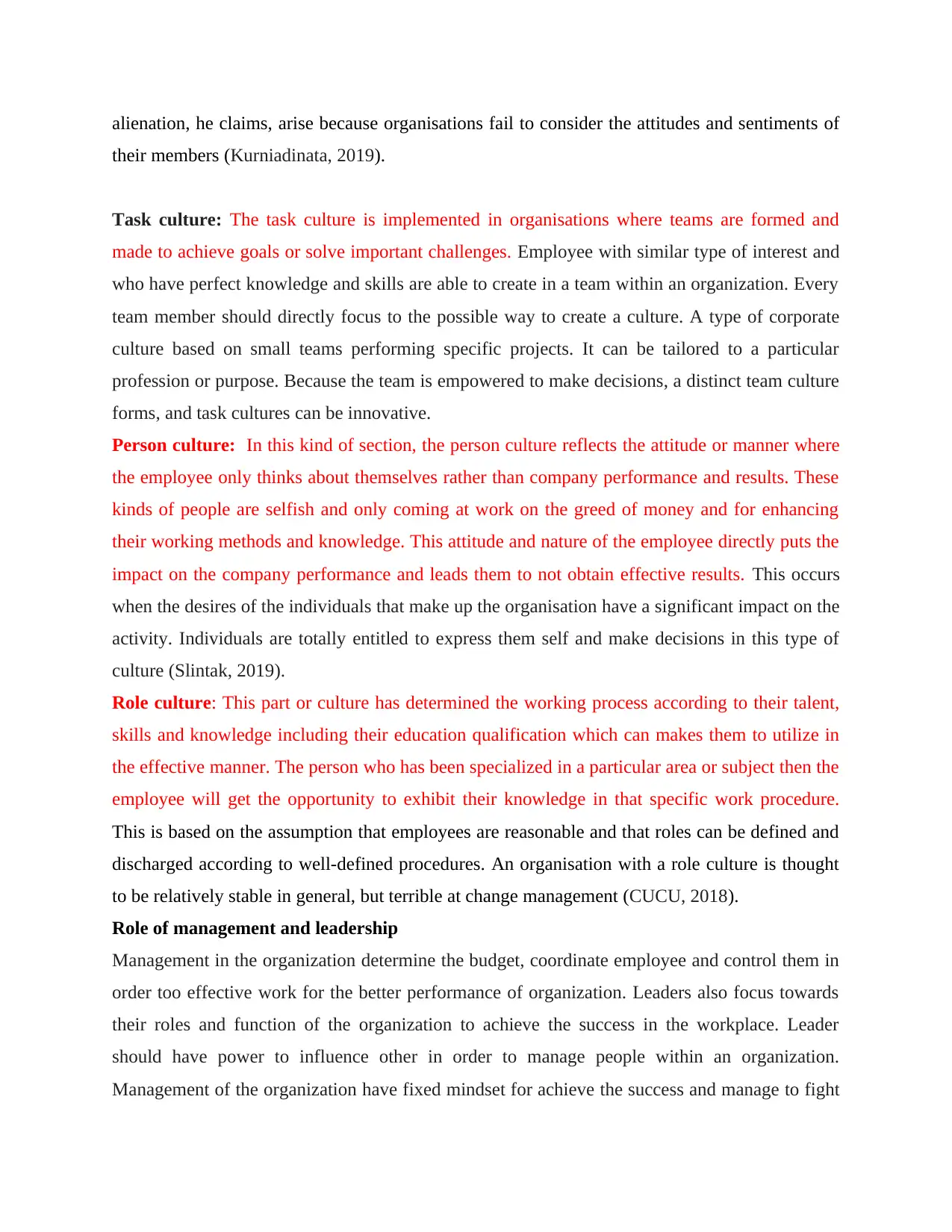
alienation, he claims, arise because organisations fail to consider the attitudes and sentiments of
their members (Kurniadinata, 2019).
Task culture: The task culture is implemented in organisations where teams are formed and
made to achieve goals or solve important challenges. Employee with similar type of interest and
who have perfect knowledge and skills are able to create in a team within an organization. Every
team member should directly focus to the possible way to create a culture. A type of corporate
culture based on small teams performing specific projects. It can be tailored to a particular
profession or purpose. Because the team is empowered to make decisions, a distinct team culture
forms, and task cultures can be innovative.
Person culture: In this kind of section, the person culture reflects the attitude or manner where
the employee only thinks about themselves rather than company performance and results. These
kinds of people are selfish and only coming at work on the greed of money and for enhancing
their working methods and knowledge. This attitude and nature of the employee directly puts the
impact on the company performance and leads them to not obtain effective results. This occurs
when the desires of the individuals that make up the organisation have a significant impact on the
activity. Individuals are totally entitled to express them self and make decisions in this type of
culture (Slintak, 2019).
Role culture: This part or culture has determined the working process according to their talent,
skills and knowledge including their education qualification which can makes them to utilize in
the effective manner. The person who has been specialized in a particular area or subject then the
employee will get the opportunity to exhibit their knowledge in that specific work procedure.
This is based on the assumption that employees are reasonable and that roles can be defined and
discharged according to well-defined procedures. An organisation with a role culture is thought
to be relatively stable in general, but terrible at change management (CUCU, 2018).
Role of management and leadership
Management in the organization determine the budget, coordinate employee and control them in
order too effective work for the better performance of organization. Leaders also focus towards
their roles and function of the organization to achieve the success in the workplace. Leader
should have power to influence other in order to manage people within an organization.
Management of the organization have fixed mindset for achieve the success and manage to fight
their members (Kurniadinata, 2019).
Task culture: The task culture is implemented in organisations where teams are formed and
made to achieve goals or solve important challenges. Employee with similar type of interest and
who have perfect knowledge and skills are able to create in a team within an organization. Every
team member should directly focus to the possible way to create a culture. A type of corporate
culture based on small teams performing specific projects. It can be tailored to a particular
profession or purpose. Because the team is empowered to make decisions, a distinct team culture
forms, and task cultures can be innovative.
Person culture: In this kind of section, the person culture reflects the attitude or manner where
the employee only thinks about themselves rather than company performance and results. These
kinds of people are selfish and only coming at work on the greed of money and for enhancing
their working methods and knowledge. This attitude and nature of the employee directly puts the
impact on the company performance and leads them to not obtain effective results. This occurs
when the desires of the individuals that make up the organisation have a significant impact on the
activity. Individuals are totally entitled to express them self and make decisions in this type of
culture (Slintak, 2019).
Role culture: This part or culture has determined the working process according to their talent,
skills and knowledge including their education qualification which can makes them to utilize in
the effective manner. The person who has been specialized in a particular area or subject then the
employee will get the opportunity to exhibit their knowledge in that specific work procedure.
This is based on the assumption that employees are reasonable and that roles can be defined and
discharged according to well-defined procedures. An organisation with a role culture is thought
to be relatively stable in general, but terrible at change management (CUCU, 2018).
Role of management and leadership
Management in the organization determine the budget, coordinate employee and control them in
order too effective work for the better performance of organization. Leaders also focus towards
their roles and function of the organization to achieve the success in the workplace. Leader
should have power to influence other in order to manage people within an organization.
Management of the organization have fixed mindset for achieve the success and manage to fight
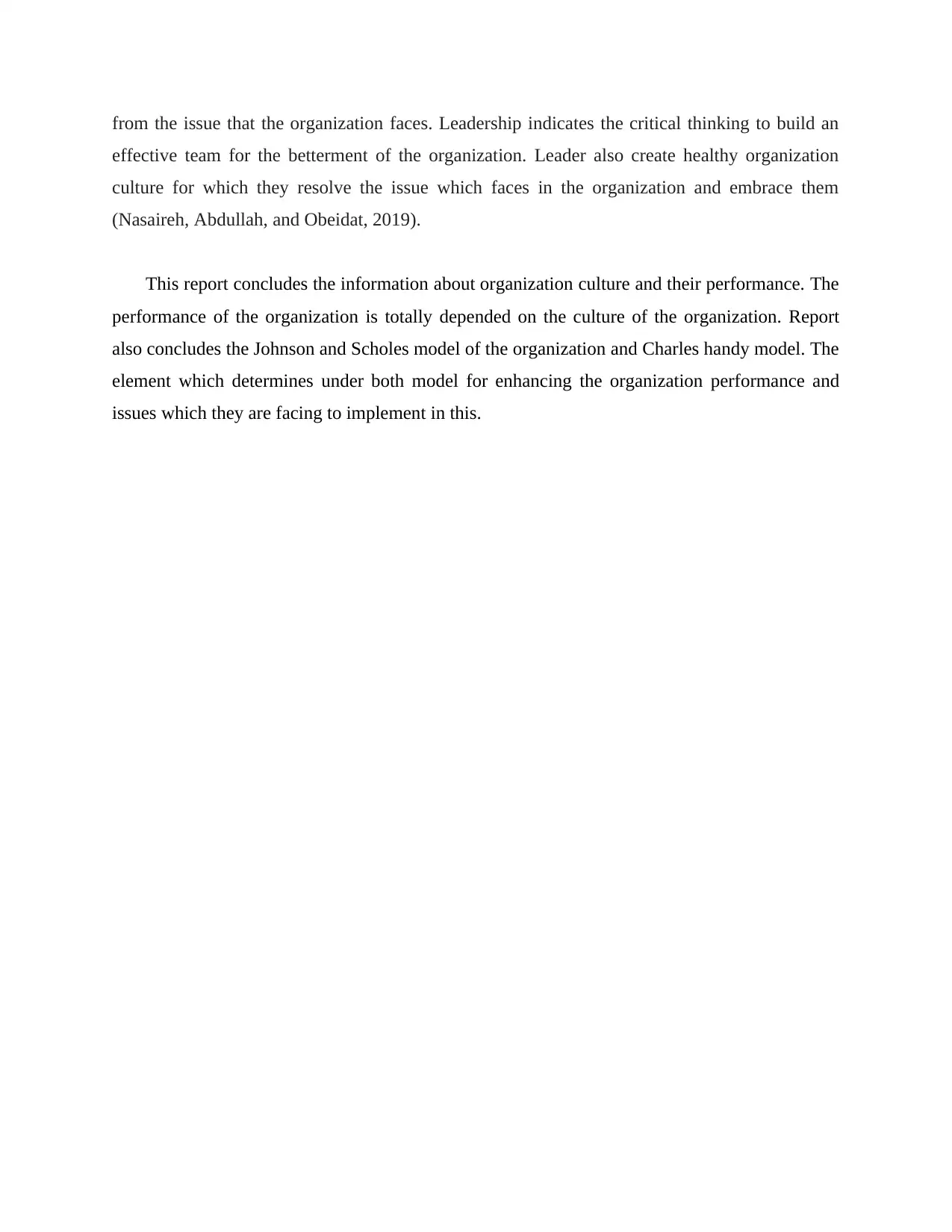
from the issue that the organization faces. Leadership indicates the critical thinking to build an
effective team for the betterment of the organization. Leader also create healthy organization
culture for which they resolve the issue which faces in the organization and embrace them
(Nasaireh, Abdullah, and Obeidat, 2019).
This report concludes the information about organization culture and their performance. The
performance of the organization is totally depended on the culture of the organization. Report
also concludes the Johnson and Scholes model of the organization and Charles handy model. The
element which determines under both model for enhancing the organization performance and
issues which they are facing to implement in this.
effective team for the betterment of the organization. Leader also create healthy organization
culture for which they resolve the issue which faces in the organization and embrace them
(Nasaireh, Abdullah, and Obeidat, 2019).
This report concludes the information about organization culture and their performance. The
performance of the organization is totally depended on the culture of the organization. Report
also concludes the Johnson and Scholes model of the organization and Charles handy model. The
element which determines under both model for enhancing the organization performance and
issues which they are facing to implement in this.
Paraphrase This Document
Need a fresh take? Get an instant paraphrase of this document with our AI Paraphraser
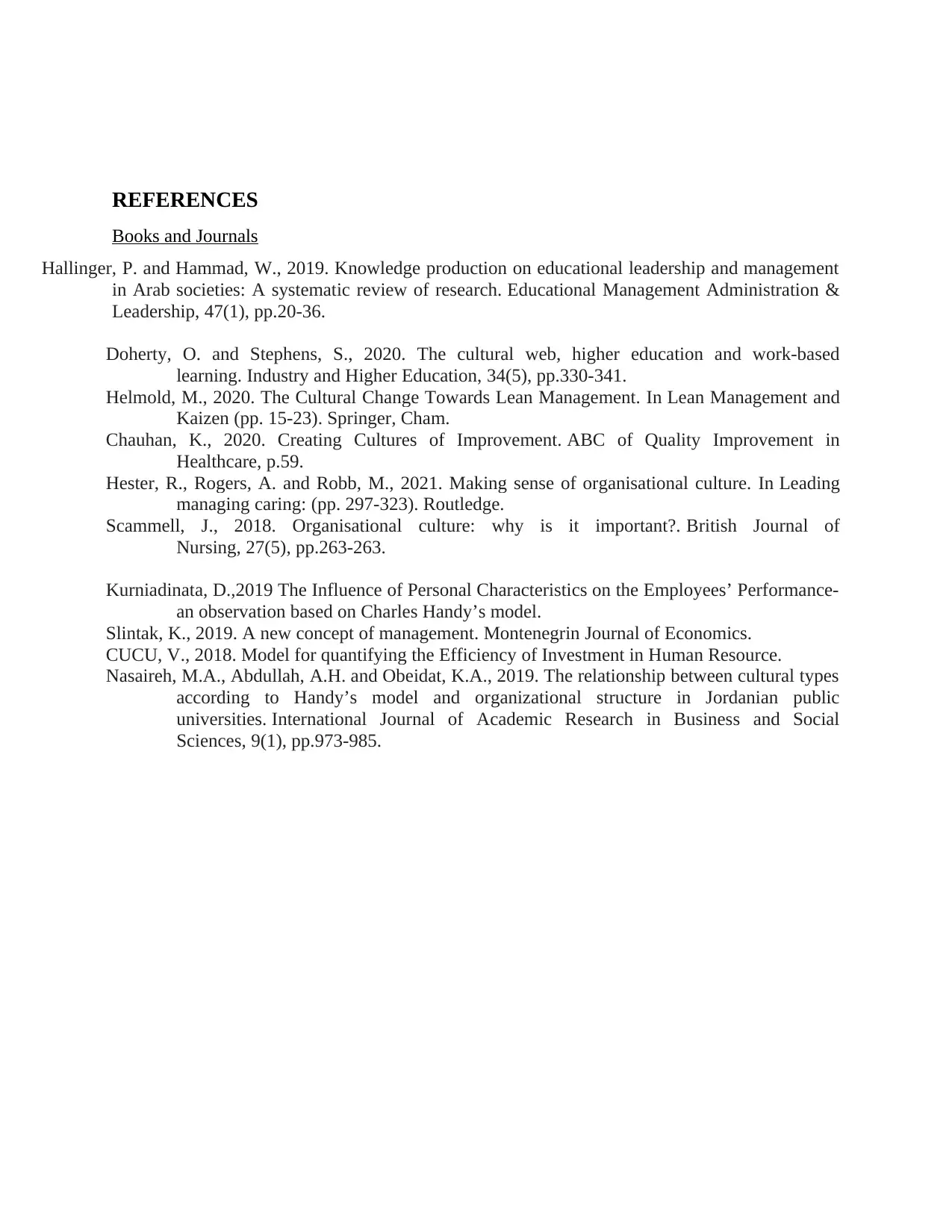
REFERENCES
Books and Journals
Hallinger, P. and Hammad, W., 2019. Knowledge production on educational leadership and management
in Arab societies: A systematic review of research. Educational Management Administration &
Leadership, 47(1), pp.20-36.
Doherty, O. and Stephens, S., 2020. The cultural web, higher education and work-based
learning. Industry and Higher Education, 34(5), pp.330-341.
Helmold, M., 2020. The Cultural Change Towards Lean Management. In Lean Management and
Kaizen (pp. 15-23). Springer, Cham.
Chauhan, K., 2020. Creating Cultures of Improvement. ABC of Quality Improvement in
Healthcare, p.59.
Hester, R., Rogers, A. and Robb, M., 2021. Making sense of organisational culture. In Leading
managing caring: (pp. 297-323). Routledge.
Scammell, J., 2018. Organisational culture: why is it important?. British Journal of
Nursing, 27(5), pp.263-263.
Kurniadinata, D.,2019 The Influence of Personal Characteristics on the Employees’ Performance-
an observation based on Charles Handy’s model.
Slintak, K., 2019. A new concept of management. Montenegrin Journal of Economics.
CUCU, V., 2018. Model for quantifying the Efficiency of Investment in Human Resource.
Nasaireh, M.A., Abdullah, A.H. and Obeidat, K.A., 2019. The relationship between cultural types
according to Handy’s model and organizational structure in Jordanian public
universities. International Journal of Academic Research in Business and Social
Sciences, 9(1), pp.973-985.
Books and Journals
Hallinger, P. and Hammad, W., 2019. Knowledge production on educational leadership and management
in Arab societies: A systematic review of research. Educational Management Administration &
Leadership, 47(1), pp.20-36.
Doherty, O. and Stephens, S., 2020. The cultural web, higher education and work-based
learning. Industry and Higher Education, 34(5), pp.330-341.
Helmold, M., 2020. The Cultural Change Towards Lean Management. In Lean Management and
Kaizen (pp. 15-23). Springer, Cham.
Chauhan, K., 2020. Creating Cultures of Improvement. ABC of Quality Improvement in
Healthcare, p.59.
Hester, R., Rogers, A. and Robb, M., 2021. Making sense of organisational culture. In Leading
managing caring: (pp. 297-323). Routledge.
Scammell, J., 2018. Organisational culture: why is it important?. British Journal of
Nursing, 27(5), pp.263-263.
Kurniadinata, D.,2019 The Influence of Personal Characteristics on the Employees’ Performance-
an observation based on Charles Handy’s model.
Slintak, K., 2019. A new concept of management. Montenegrin Journal of Economics.
CUCU, V., 2018. Model for quantifying the Efficiency of Investment in Human Resource.
Nasaireh, M.A., Abdullah, A.H. and Obeidat, K.A., 2019. The relationship between cultural types
according to Handy’s model and organizational structure in Jordanian public
universities. International Journal of Academic Research in Business and Social
Sciences, 9(1), pp.973-985.
1 out of 8
Related Documents
Your All-in-One AI-Powered Toolkit for Academic Success.
+13062052269
info@desklib.com
Available 24*7 on WhatsApp / Email
![[object Object]](/_next/static/media/star-bottom.7253800d.svg)
Unlock your academic potential
© 2024 | Zucol Services PVT LTD | All rights reserved.





